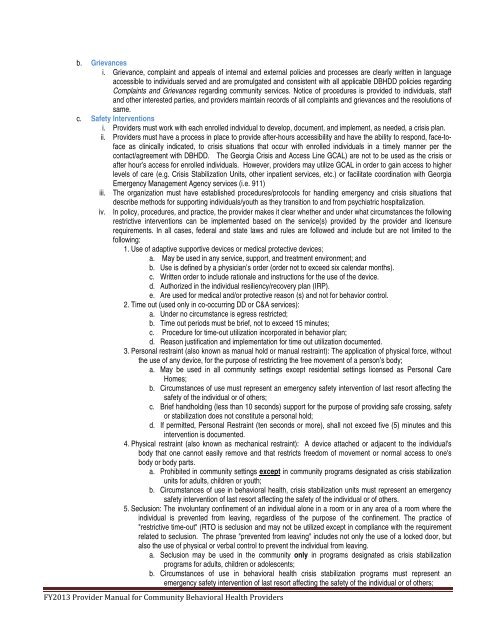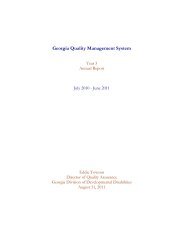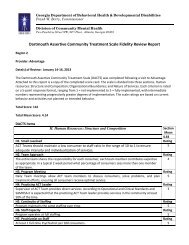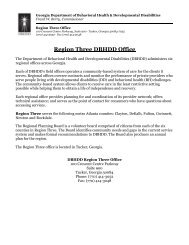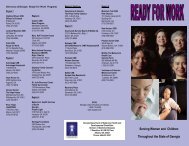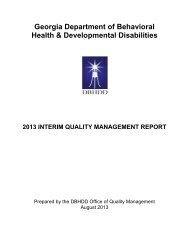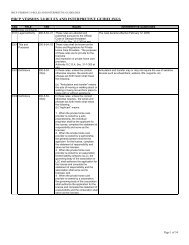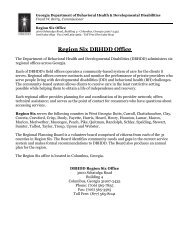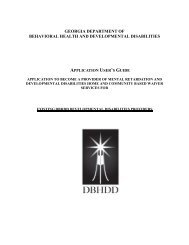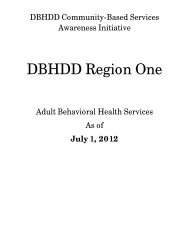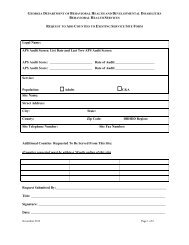PART I - Department of Behavioral Health and Developmental ...
PART I - Department of Behavioral Health and Developmental ...
PART I - Department of Behavioral Health and Developmental ...
Create successful ePaper yourself
Turn your PDF publications into a flip-book with our unique Google optimized e-Paper software.
. Grievancesi. Grievance, complaint <strong>and</strong> appeals <strong>of</strong> internal <strong>and</strong> external policies <strong>and</strong> processes are clearly written in languageaccessible to individuals served <strong>and</strong> are promulgated <strong>and</strong> consistent with all applicable DBHDD policies regardingComplaints <strong>and</strong> Grievances regarding community services. Notice <strong>of</strong> procedures is provided to individuals, staff<strong>and</strong> other interested parties, <strong>and</strong> providers maintain records <strong>of</strong> all complaints <strong>and</strong> grievances <strong>and</strong> the resolutions <strong>of</strong>same.c. Safety Interventionsi. Providers must work with each enrolled individual to develop, document, <strong>and</strong> implement, as needed, a crisis plan.ii. Providers must have a process in place to provide after-hours accessibility <strong>and</strong> have the ability to respond, face-t<strong>of</strong>aceas clinically indicated, to crisis situations that occur with enrolled individuals in a timely manner per thecontact/agreement with DBHDD. The Georgia Crisis <strong>and</strong> Access Line GCAL) are not to be used as the crisis orafter hour’s access for enrolled individuals. However, providers may utilize GCAL in order to gain access to higherlevels <strong>of</strong> care (e.g. Crisis Stabilization Units, other inpatient services, etc.) or facilitate coordination with GeorgiaEmergency Management Agency services (i.e. 911)iii. The organization must have established procedures/protocols for h<strong>and</strong>ling emergency <strong>and</strong> crisis situations thatdescribe methods for supporting individuals/youth as they transition to <strong>and</strong> from psychiatric hospitalization.iv. In policy, procedures, <strong>and</strong> practice, the provider makes it clear whether <strong>and</strong> under what circumstances the followingrestrictive interventions can be implemented based on the service(s) provided by the provider <strong>and</strong> licensurerequirements. In all cases, federal <strong>and</strong> state laws <strong>and</strong> rules are followed <strong>and</strong> include but are not limited to thefollowing:1. Use <strong>of</strong> adaptive supportive devices or medical protective devices;a. May be used in any service, support, <strong>and</strong> treatment environment; <strong>and</strong>b. Use is defined by a physician’s order (order not to exceed six calendar months).c. Written order to include rationale <strong>and</strong> instructions for the use <strong>of</strong> the device.d. Authorized in the individual resiliency/recovery plan (IRP).e. Are used for medical <strong>and</strong>/or protective reason (s) <strong>and</strong> not for behavior control.2. Time out (used only in co-occurring DD or C&A services):a. Under no circumstance is egress restricted;b. Time out periods must be brief, not to exceed 15 minutes;c. Procedure for time-out utilization incorporated in behavior plan;d. Reason justification <strong>and</strong> implementation for time out utilization documented.3. Personal restraint (also known as manual hold or manual restraint): The application <strong>of</strong> physical force, withoutthe use <strong>of</strong> any device, for the purpose <strong>of</strong> restricting the free movement <strong>of</strong> a person’s body;a. May be used in all community settings except residential settings licensed as Personal CareHomes;b. Circumstances <strong>of</strong> use must represent an emergency safety intervention <strong>of</strong> last resort affecting thesafety <strong>of</strong> the individual or <strong>of</strong> others;c. Brief h<strong>and</strong>holding (less than 10 seconds) support for the purpose <strong>of</strong> providing safe crossing, safetyor stabilization does not constitute a personal hold;d. If permitted, Personal Restraint (ten seconds or more), shall not exceed five (5) minutes <strong>and</strong> thisintervention is documented.4. Physical restraint (also known as mechanical restraint): A device attached or adjacent to the individual'sbody that one cannot easily remove <strong>and</strong> that restricts freedom <strong>of</strong> movement or normal access to one'sbody or body parts.a. Prohibited in community settings except in community programs designated as crisis stabilizationunits for adults, children or youth;b. Circumstances <strong>of</strong> use in behavioral health, crisis stabilization units must represent an emergencysafety intervention <strong>of</strong> last resort affecting the safety <strong>of</strong> the individual or <strong>of</strong> others.5. Seclusion: The involuntary confinement <strong>of</strong> an individual alone in a room or in any area <strong>of</strong> a room where theindividual is prevented from leaving, regardless <strong>of</strong> the purpose <strong>of</strong> the confinement. The practice <strong>of</strong>"restrictive time-out" (RTO is seclusion <strong>and</strong> may not be utilized except in compliance with the requirementrelated to seclusion. The phrase "prevented from leaving" includes not only the use <strong>of</strong> a locked door, butalso the use <strong>of</strong> physical or verbal control to prevent the individual from leaving.a. Seclusion may be used in the community only in programs designated as crisis stabilizationprograms for adults, children or adolescents;b. Circumstances <strong>of</strong> use in behavioral health crisis stabilization programs must represent anemergency safety intervention <strong>of</strong> last resort affecting the safety <strong>of</strong> the individual or <strong>of</strong> others;FY2013 Provider Manual for Community <strong>Behavioral</strong> <strong>Health</strong> Providers


